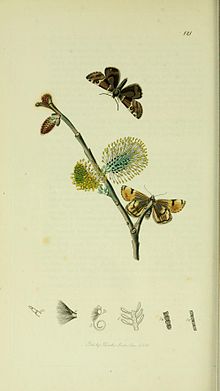Middle virgin child
| Middle virgin child | ||||||||||||
|---|---|---|---|---|---|---|---|---|---|---|---|---|

Middle virgin child ( Boudinotiana notha ) |
||||||||||||
| Systematics | ||||||||||||
|
||||||||||||
| Scientific name | ||||||||||||
| Boudinotiana notha | ||||||||||||
| ( Huebner , 1803) |
The middle virgin child ( Boudinotiana notha ), also small aspen day owl , poplar virgin child or meadow virgin child is a butterfly ( moth ) from the Spanner family (Geometridae).
features
The male moths reach a wingspan of 29 to 34 millimeters, the female moths 27 to 31 mm. The forewings are brownish with light gray admixtures. The females often show a bluish hue. The drawing of the forewings is clearly pronounced with a black, diagonal inner transverse line, which is delimited distally by the dark gray median band. The rest of the median field and the basal field are light gray. The hind wings show a clear discal spot. The fringes are uniformly dark in color. The hind wings are darkly patterned on a yellow background. The males lack the white spot on the Kostal edge. In the hind wing veins, Sc + R1 and Rs extend over more than half of the cell. Rs and M1 are usually fused, rarely with a short stalk.
The antennae of the males are briefly double-combed (bipectinate), those of the females are thread-like (filiform). The hind wings are darkly patterned on a yellow background.
The caterpillar is black in the first stages,
The pupa is relatively slim and light red-brown. Two pointed thorns protrude from the side of the conical, small cremaster .
Similar species
This species is very similar to the Great Virgin Child ( Archiearis parthenias ), but the black-gray and white interferences in the dark brown of the front wings are missing. The black discal spot on the hind wing is smaller in both sexes. The male of the Great Virgin Child has thread-like antennae, the female is significantly larger. The male also usually has clearly pronounced white spots on the costal margin, a large discal spot on the hind wing and piebald fringes, and the hind wing veins also differ.
Geographical distribution and habitat
The range of the species extends over the temperate and cool zones of Europe . The species is only very rarely found in southern Europe. There are small deposits in the Eastern Pyrenees, in central Spain in Tuscany, on the island of Krk, and on the northern Balkan Peninsula. It is also absent in Ireland. The middle and northern parts of Fennoscandia are also not populated by this species. In the east, the distribution area extends over Central Russia, the Caucasus region and northern Turkey, over southern Siberia to the Russian Far East and Japan. Overall, the species is quite rare, only common in individual regions.
This species is found in raised bogs with birch trees , poplar plantations , in sparse forests with quivering poplars ( Populus tremula ), on the edges of forests , in heather areas and lake shores with willows and poplars. In the mountains they rise up to 1000 m above sea level.
Way of life
The middle virgin child forms one generation per year. The diurnal moths fly from the beginning of March to the end of April, often later in the north of the range. In the first warm days of the year, the moths can usually be found in the morning in the sunshine, flying around the crowns of aspen or birch trees, often sucking nectar on blooming pussy willows or tree sap. The flight hours decrease the colder and wetter a spring is. The caterpillar season is from May to July, in the north even a little later. The caterpillars feed on the leaves of aspen ( Populus tremula ), Sal willow ( Salix caprea ) and birch ( Betula ). In Japan, the caterpillars can be found on Populus nigra . Breeding is also successful with Salix alba and Salix viminalis . The caterpillars live between spun leaves. Pupation takes place on the ground or in rotten wood at the foot or in the immediate vicinity of the host trees. The pupa overwinters, often two or even three winters.
Systematics
The populations in the Russian Far East, Northern China and Japan are considered to be their own subspecies:
- B. notha suifunensis Kardakoff, 1928, Russian Far East
- B. notha okanoi Inoue, 1958, Northern Japan
swell
Individual evidence
- ↑ Red lists at Science4you
- ↑ Ebert (2001: pp. 25–28)
- ↑ a b Hausmann (2001: pp. 84–86)
literature
- Axel Hausmann: The Geometrid Moths of the World . In: Axel Hausmann (Ed.): The Geometrid Moths of Europe . 1st edition. Volume 1: Introduction. Achiearinae, Orthostixinae, Desmobathrinae, Alsophilinae, Geometrinae. Apollo Books, Stenstrup 2001, ISBN 87-88757-37-4 (English).
- Walter Forster , Theodor A. Wohlfahrt : The butterflies of Central Europe. Volume 5: Spanner. (Geometridae). Franckh'sche Verlagshandlung, Stuttgart 1981, ISBN 3-440-04951-5 .
- Günter Ebert (Ed.): The butterflies of Baden-Württemberg . 1st edition. tape 8 . Moth VI. Spanner (Geometridae) 1st part. Eugen Ulmer, Stuttgart 2001, ISBN 3-8001-3497-7 .
- Patrice Leraut: Geometrid moths . In: Moths of Europe . 1st edition. Volume II. NAP Editions, 2009, ISBN 978-2-913688-09-4 (English).
Web links
- Lepiforum e. V. Taxonomy and Photos
- www.schmetterling-raupe.de
- Moths and Butterflies of Europe and North Africa (English)
- Markku Savela: Lepidoptera and some other life forms (English)
- Collection of the Natural History Museum Stockholm (Swedish)
- Boudinotiana notha at Fauna Europaea
